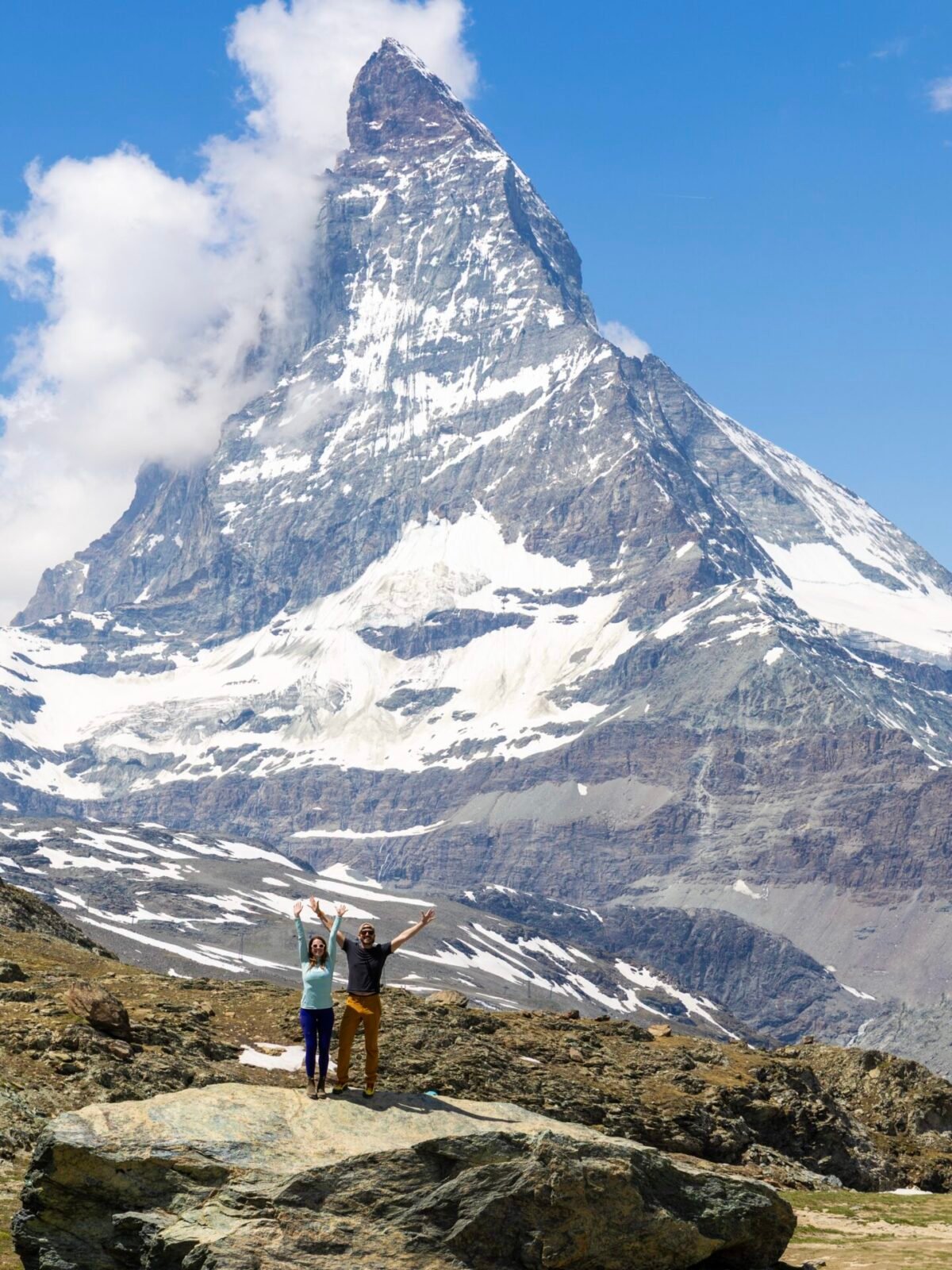
10-day Switzerland itinerary: Zermatt, Interlaken, Jungfrau & beyond!
Switzerland is home to some of the most spectacular mountain scenery in the world— jagged snow-capped peaks, turquoise glacial lakes, and flowering alpine meadows straight from the pages of a storybook. But unlike other destinations that require long backcountry treks to experience jaw-dropping views, Switzerland’s extensive network of gondolas, funiculars, and chairlifts provides unparalleled access for seasoned mountaineers and casual hikers alike.
After tackling both of Switzerland’s most iconic long-distance trails in previous years (the Tour du Mont Blanc and the Haute Route from Chamonix to Zermatt), I returned this June to explore the country by train, linking picturesque towns to gorgeous day hikes and epic mountaintop views. Less than 3 months after knee surgery, I was thrilled to discover just how much Swiss magic you can experience without strapping in for a full multi-day trek!
This 10-day Switzerland itinerary is designed to showcase some of the country’s most breathtaking alpine landscapes off the long-distance hiking trail—prioritising high-value day hikes, accessible viewpoints, and quintessential Swiss Alps experiences. Whether you’re an avid hiker short on time or a casual traveller chasing mountain views without the commitment of a two-week trek, this route delivers the very best of the Alps!
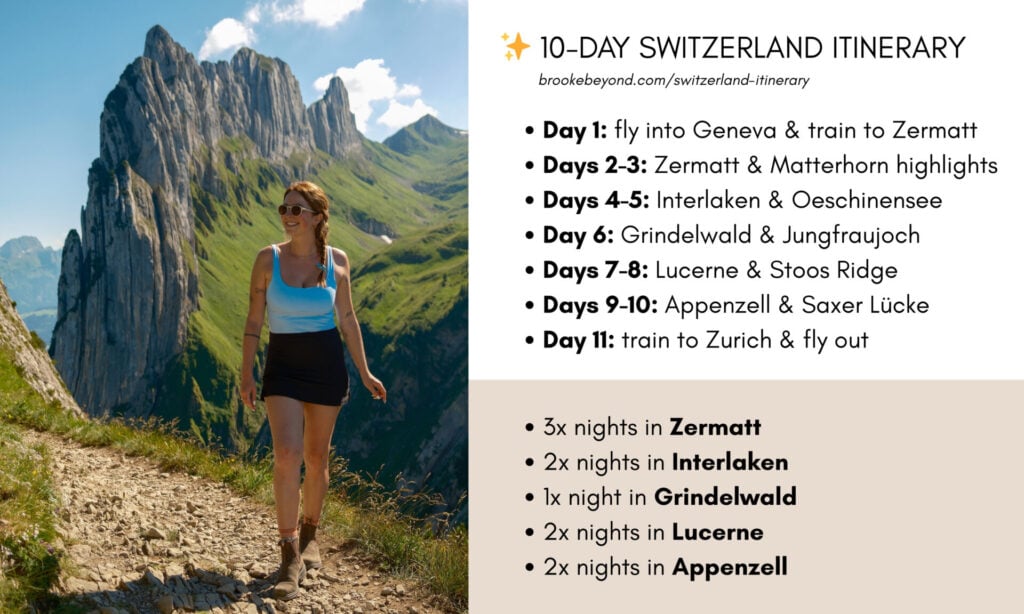
Itinerary map
Here’s an overview map of my 10-day Switzerland itinerary, from Geneva to Zürich through some of the country’s most spectacular scenery. Keep reading for trip logistics and a detailed day-by day plan that will deliver you to stunning viewpoints and high-value hikes around the Swiss Alps!
Switzerland trip logistics
When to go
The best time to follow this 10-day Switzerland itinerary is during the hiking season from May to October, when trails are largely snow-free, gondolas are running on full schedules, and alpine towns are lively.
- May – early June: This is early shoulder season in the Alps, so some high-mountain trails and gondolas may still be closed due to lingering snow. Lower-elevation hikes and lake destinations (like Lake Brienz and Stoos Ridge) are typically accessible, and most importantly, towns are much quieter with fewer tourists!
- late June – early September: This is peak summer hiking season in Switzerland, when all gondolas, trains, and alpine trails are open, and wildflowers blanket the meadows. It’s the best time to access high-elevation areas like Gornergrat, Matterhorn Glacier Paradise, Jungfraujoch, and Saxer Lücke; expect warm days, clear skies, but also the largest crowds.
- mid September – October: Early autumn is a beautiful and slightly quieter time to explore Switzerland, with fewer tourists, golden larches, and cooler mountain weather. Most gondolas and trains still operate until mid-October, but check seasonal schedules in advance; lower-elevation hikes and scenic train rides are especially stunning at this time of year!
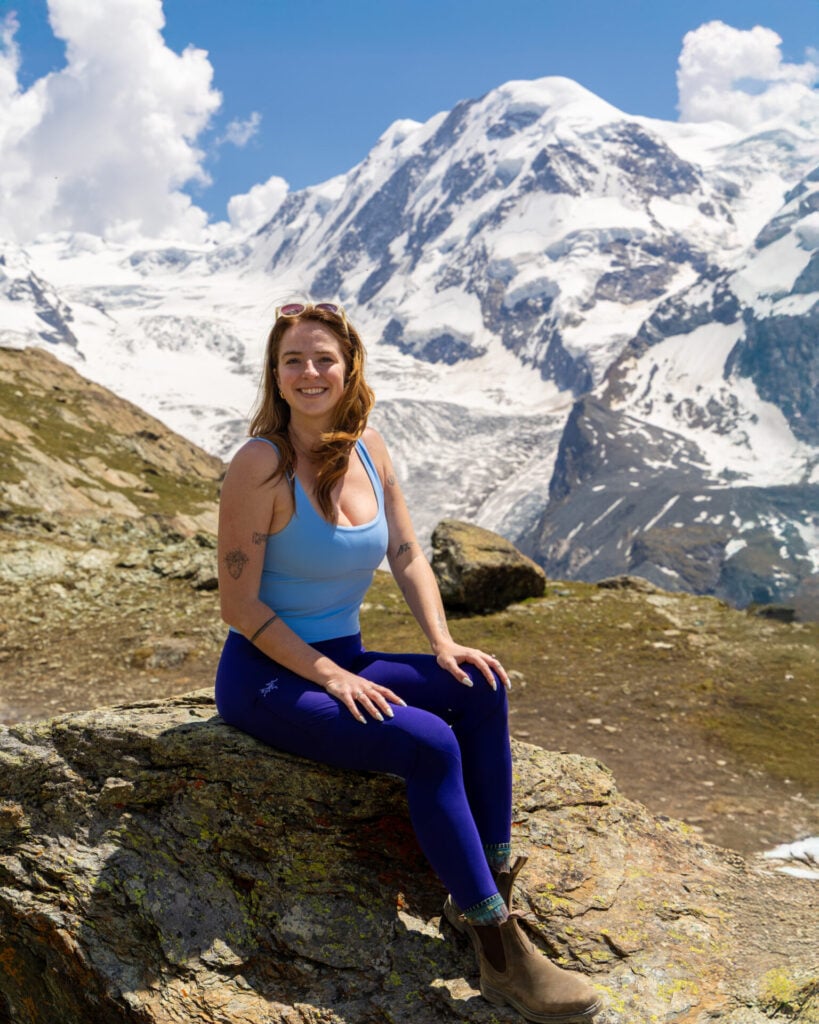
Getting there
This itinerary is designed as a one-way route between Geneva and Zürich, and although I’ve written it south to north, it can just as easily be done in reverse. You can also turn the itinerary into a loop starting and ending in Geneva—there’s a direct train from Appenzell to Geneva Airport in around 5hrs with just a single transfer in Gossau, so adapt as needed depending on your onwards travel plans!
- Starting point: Geneva
- Ending point: Zürich
Getting around
This 10-day itinerary is specifically optimised for Switzerland’s incredible public transport network, and all towns, hikes, and activities described here are fully accessible by train, gondola, funicular, or bus. In fact, in many regions (particularly Zermatt, Interlaken, and Grindelwald), public transport is the ONLY realistic way to get around, with car-free zones, expensive parking, and limited road access making driving either impossible or highly impractical.
That said, the latter half of the itinerary (Lucerne & Appenzell Alps) involves a few more complex or indirect train connections, which can be streamlined by hiring a car. To save time and add flexibility, we caught a train from Grindelwald to Zürich mid-itinerary, picked up a rental car, and drove the final few days. With 4 people in our group, it ended up being both more convenient and more affordable than train tickets, but it’s definitely not essential if you’d prefer to stick with public transport.
Where to stay
You’ll be staying in local hotels or guesthouses for the duration of this 10-day itinerary. Accommodation in Switzerland can be expensive, so it’s best to book well in advance— particularly in Zermatt, Grindelwald, and Appenzell, where affordable rooms sell out quickly. If you’re travelling in a small group (with family or a few friends), Airbnb quickly becomes more affordable!
- Zermatt (3 nights): Hotel Jägerhof (Matterhorn views and free pick-up from the train station) or Hotel Berghof (comfortable chalet-style hotel near the Matterhorn Glacier Paradise lift)
- Interlaken (2 nights): Hotel Beausite (charming family-run hotel with mountain views and a great breakfast) or Hotel Alphorn (affordable, no-frills guesthouse)
- Grindelwald (1 night): Derby Swiss Quality Hotel (right next to the main train station in Grindelwald centre) or Eiger Lodge Chic (right next to the Eiger Express, more convenient for Jungfraujoch)
- Lucerne (2 nights): GLANDON Rooms Haldenhof (simple, spacious studios with kitchenettes and lake access) or Hotel Royal Luzern (classic hotel with lake views, 15min walk from the Old Town)
- Appenzell (2 nights): Hotel Löwen or Hotel Adler (both mid-range options in the town centre with easy transport access)
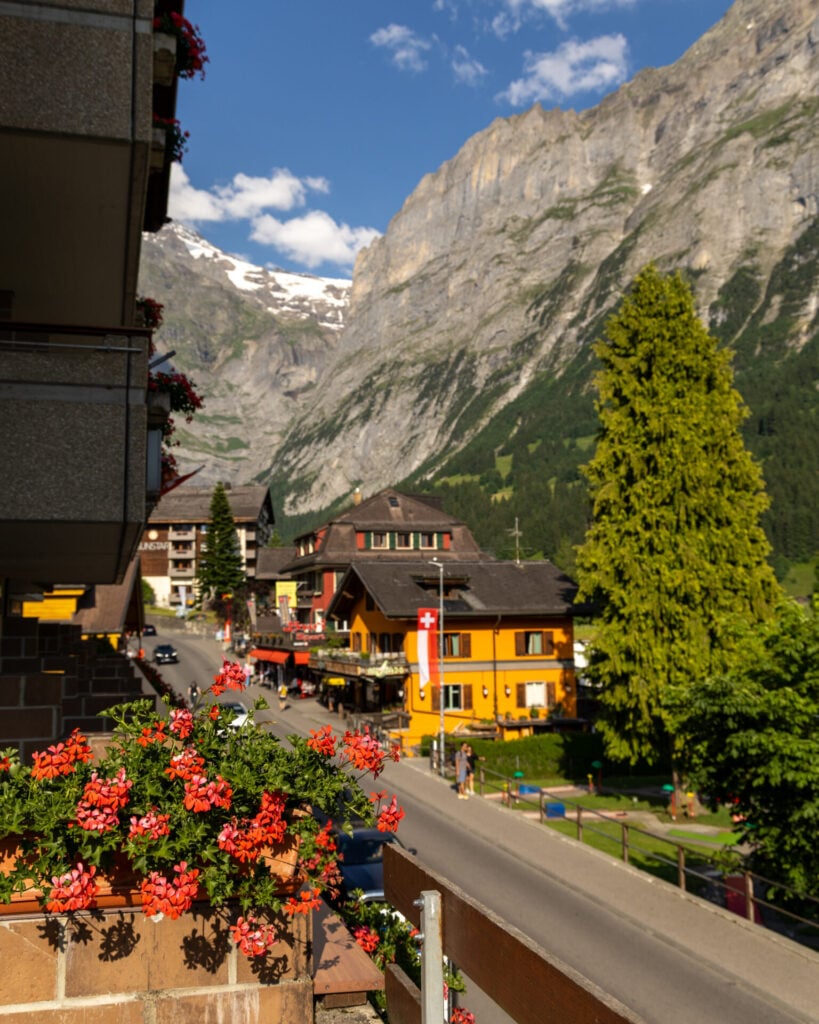
Budget travel in Switzerland
Let’s be real: this is not a budget itinerary. Switzerland is one of the most expensive travel destinations in the world, and visiting in the summer with designs on seeing the country’s best viewpoints and hiking trails simply isn’t possible on a shoestring.
Trains, gondolas, mountain hotels, and restaurant meals do add up shockingly fast… but after several trips around the country, I’ve learned how to maximise value in all the right places, so you can still experience Switzerland’s incredible landscapes and iconic experiences without going totally broke.
Here are my top money-saving tips for stretching your budget in Switzerland:
→ Prioritise supermarkets over restaurant meals
Both Coop and Migros supermarkets (conveniently located in the town centre of every destination on this itinerary) offer a wide selection of fresh, pre-made meals like sandwiches, salads, and wraps that are perfect for trail lunches, as well as ready-to-heat curries, pastas, and pizzas that make an excellent dinner when you have a microwave or oven.
I absolutely love food and believe it’s one of the most important parts of travel— but in Switzerland, where the cuisine isn’t quite the cultural event it is in places like Ethiopia or Thailand, eating out is rarely worth the cost. Opt for supermarkets, pack picnics, and save your budget for the activities!
→ Score amazing food deals using TooGoodToGo
This app is one of my favourite travel hacks for saving money on meals AND reducing food waste, and it’s widely used in Switzerland (at least a few participating locations in every town on this itinerary). For under $10, you can grab a “mystery bag” of surplus items worth 3x as much from local supermarkets, bakeries, or restaurants.
My favourites are the bakery bags (Bäckerei Fuchs or Brezelkönig in Zermatt, especially), packed with pastries, fresh bread, and pre-made sandwiches that make amazing trail lunches. You can also get good Coop bags (meat or vegetarian) with prepared meals, salads, cheeses, and deli items— just add a few extras and you’ve got dinner sorted.
→ Buy the Swiss Half Fare Travelcard
At 120CHF, this travel pass gives you 50% off public transport across Switzerland, including all the regional trains on this itinerary, scenic trains (like the Gornergrat Railway), gondolas, funiculars, and local buses. The Half Fare Travelcard easily pays for itself— combined, James and I saved nearly $1,000 in transport costs using this card!
→ Book trains & accommodation early
Many of Switzerland’s budget-friendly hotels and guesthouses book out well in advance, leaving only top-tier luxury hotels with eye-watering price tags. Likewise, train fares are often cheaper when booked ahead, especially on popular intercity routes. Planning in advance can make a massive difference to your total spend!



🗺️ TRAVEL TIPS FOR SWITZERLAND
→ Language: Switzerland has 4 national languages (German, French, Italian & Romansh), but most of this itinerary takes place in the German-speaking regions; English is also widely spoken, especially in tourist hubs, and the language barrier is fairly non-existent
→ Currency: Swiss Franc (CHF); the exchange is slightly less favourable than the Euro and prices are extortionate
→ Tourist visa: Switzerland is part of the Schengen Zone— most nationalities (including AUS, USA, UK) can enter visa-free for up to 90 days within any 180-day period
→ SIM card: install an eSIM for Switzerland via Airalo; coverage is excellent even in the mountains, but download offline maps for remote hikes
→ Transport passes: we strongly recommend purchasing the Swiss Half Fare Travelcard for 120CHF, which gives 50% off all trains, gondolas, and funiculars (and saves HUNDREDS on this itinerary!)
→ Packing list: check out my essential day-hike packing list and advice on choosing the best hiking boots, backpacks, and outdoor layers
→ Essential apps: SBB (Swiss railway app for streamlined train reservations); Google Maps (download for offline use); CalTopo GPS (best low-cost GPS map for outdoor nav)
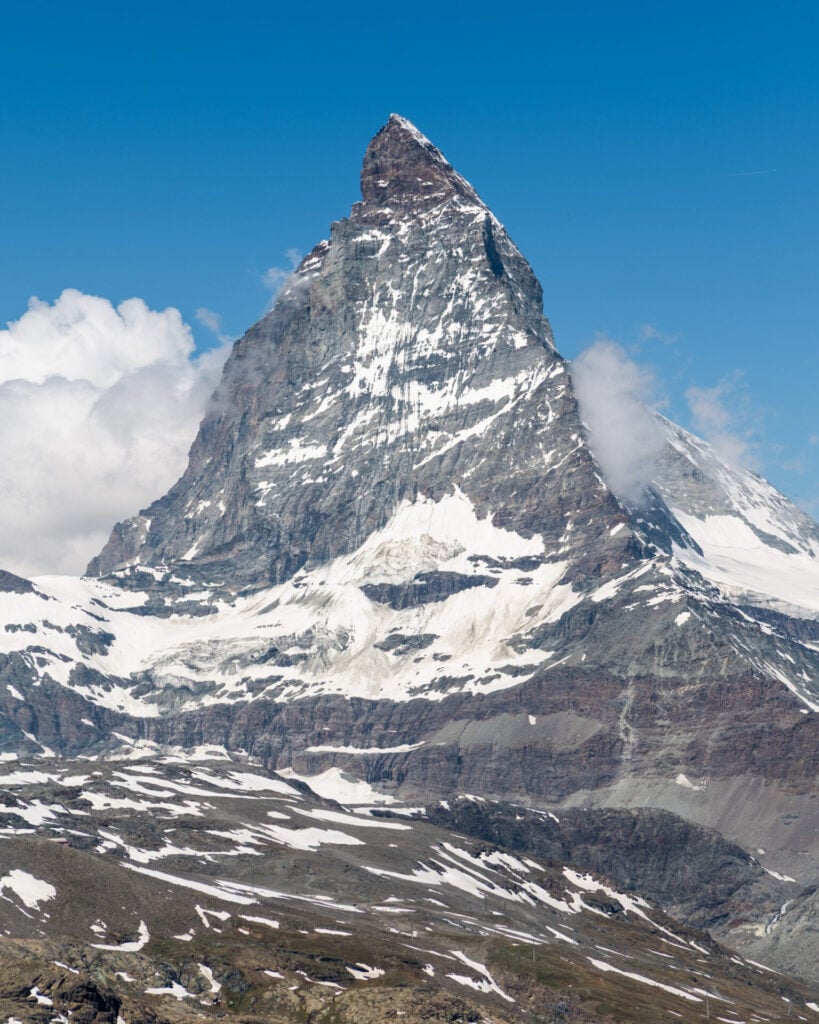
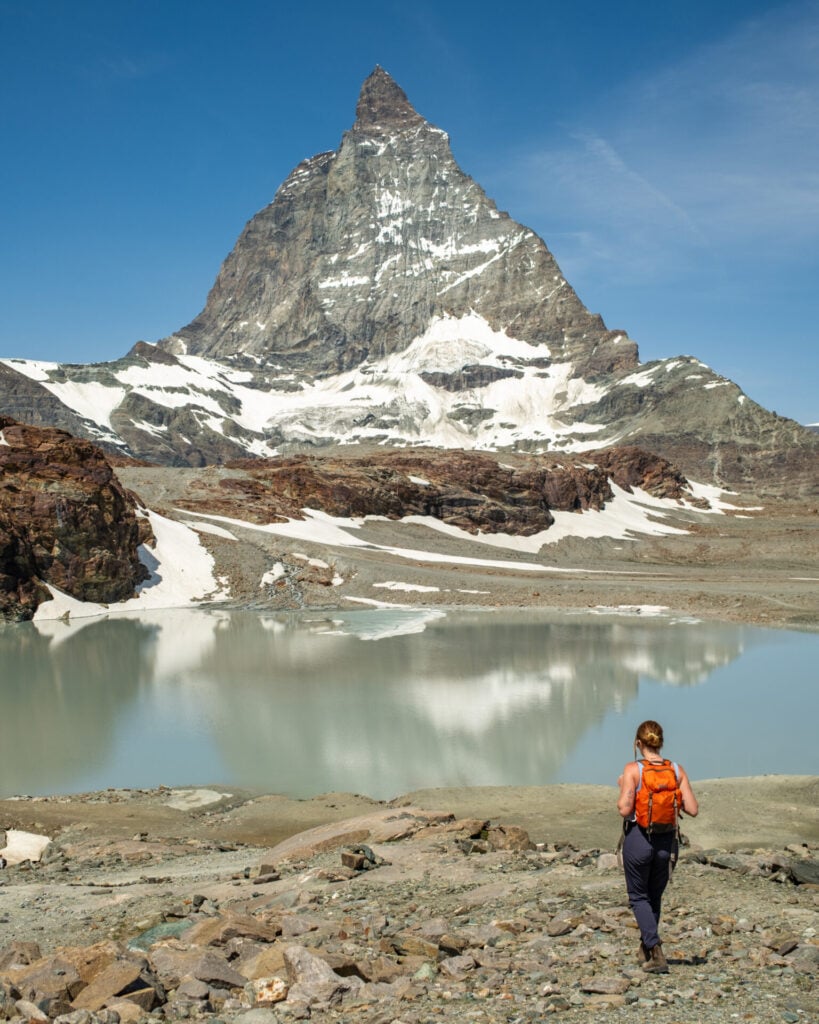
*Detailed 10-day Switzerland itinerary
- Day 1: fly into Geneva & train to Zermatt
- Days 2-3: Zermatt
- Days 4-5: Interlaken
- Day 6: Grindelwald & Jungfraujoch
- Days 7-8: Lucerne
- Days 9-10: Appenzell
- Day 11: train to Zurich & fly out
Days 1–3: Zermatt
Set beneath the jagged peak of the Matterhorn, Zermatt is one of Switzerland’s most iconic alpine towns—and the perfect place to kick off your trip. With world-class hiking trails, panoramic cable cars, and charming chalet-lined streets, it’s a dream for mountain lovers of all experience levels!
Getting to Zermatt
From Geneva Airport, it’s super easy to reach Zermatt by train— the journey takes around 4hrs with just a single transfer in Visp. The final leg of the trip winds through a gorgeous alpine valley, so try to sit on the right-hand side of the train for the best views!


What to do in Zermatt
This itinerary includes 1 travel day to reach Zermatt (from Geneva Airport) and 2 full days to explore the countless hiking trails, scenic viewpoints, and epic mountain excursions that make this town so iconic. For a short visit, here’s exactly how I’d recommend spending your 2 days:
AM Day 2: Gornergrat to Riffelberg hike
For spectacular views of the Matterhorn, the enormous Monte Rosa massif, and the Gorner Glacier (as well as 29 peaks over 4,000m), there’s no better day-hike than Gornergrat to Riffelberg. Prioritise this one on a clear morning to make the most of the views!
- Getting there: catch the scenic Gornergrat Railway from downtown Zermatt up to the spectacular Gornergrat observatory at 3,089m (10,132ft); the ride takes 30min, sit on the right for the best views!
- Tickets: a return journey costs 108CHF (54CHF with the Swiss Half Fare Travelcard) and can easily be booked day-of at the Gornergrat Railway station, located directly across from Zermatt’s main train station
- Hike details: from the Gornergrat summit, descend 5km (560m loss) past insta-worthy Matterhorn viewpoints at Rotenboden and the reflective alpine lake Riffelsee, eventually reaching the station at Riffelberg; if you prefer to ascend instead of descend (as I did post-knee-surgery), you can also hike this route in reverse
- Time needed: allow 4-5hrs to catch the train up to Gornergrat, explore the viewpoint platforms, hike down to Riffelberg (taking hundreds of photos along the way), and return to Zermatt by train
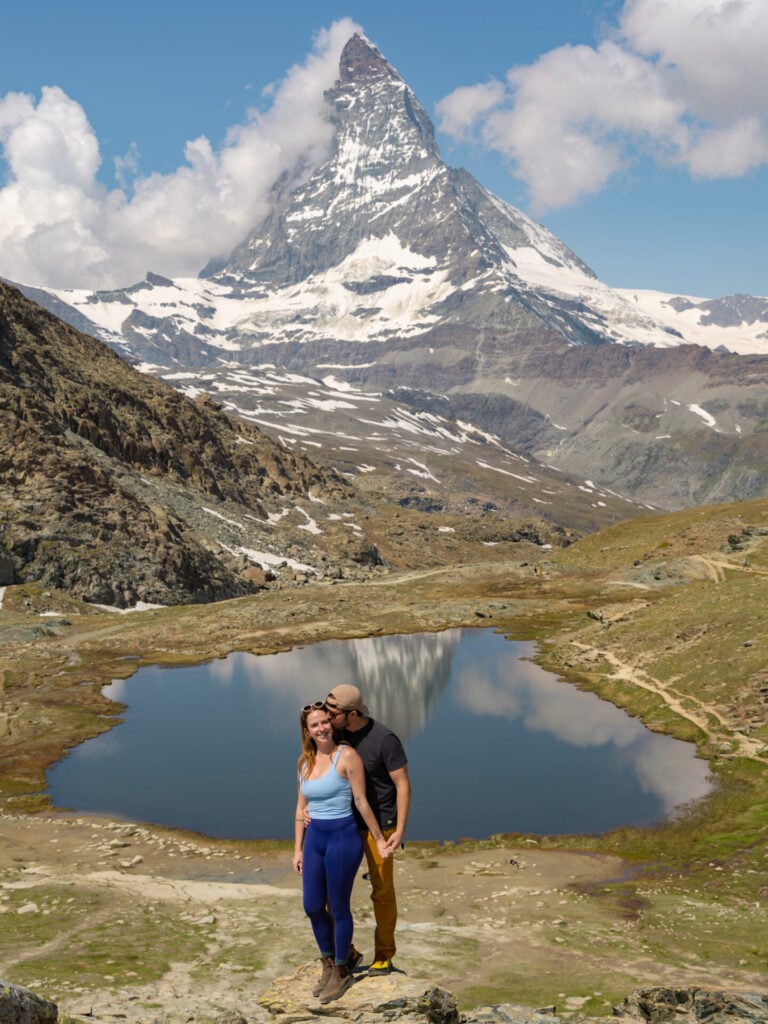
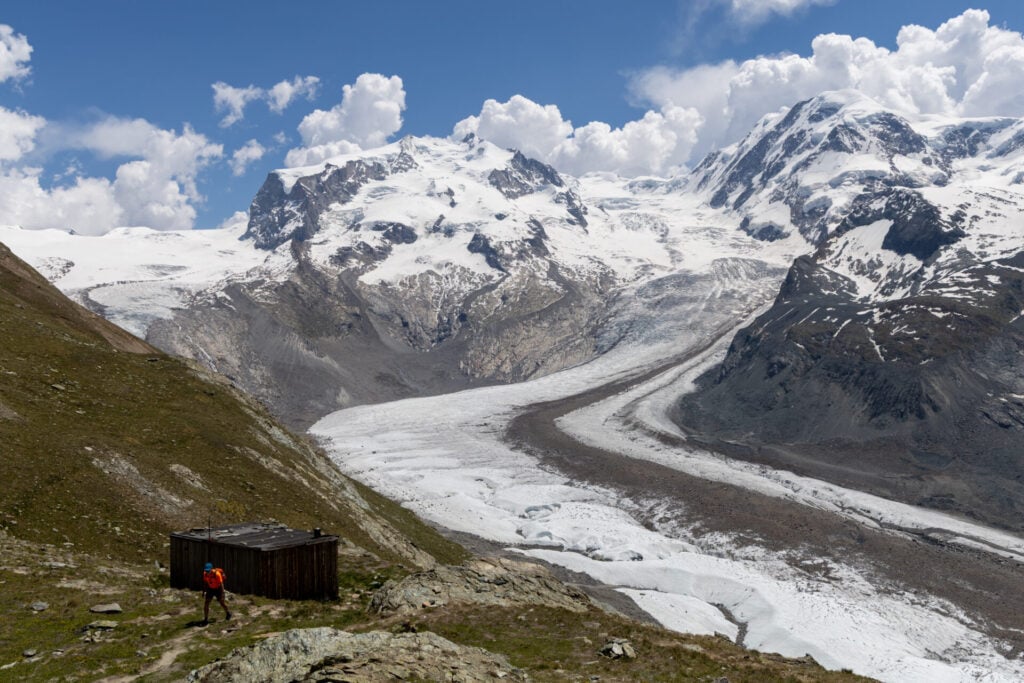
PM Day 2: Five Lakes hike (Blauherd to Sunnega)
This relaxed alpine trail winds past five sparkling mountain lakes, each offering a different perspective of the Matterhorn and surrounding peaks— this is a great afternoon activity following Gornergrat (or Glacier Paradise) in the morning!
- Getting there: take the funicular from Zermatt to Sunnegga, then transfer to the gondola up to Blauherd
- Tickets: a return trip to Blauherd costs 38CHF (19CHF with the Swiss Half Fare Travelcard), and tickets can be purchased day-of from the lift station
- Hike details: from Blauherd, follow the 10km trail downhill (500m loss) past all 5 alpine lakes—Stellisee, Grindjisee, Grünsee, Moosjisee, and Leisee— before finishing at Sunnegga; if short on time or energy, you can also just walk 15min from Blauherd to Stellisee (the most spectacular lake!), take some photos, and return the same way
- Time needed: allow 3-4hrs for the entire excursion, including transport up and back; if you just want to visit Stellisee, you’ll only need ~1.5hrs (30min of hiking + transport)
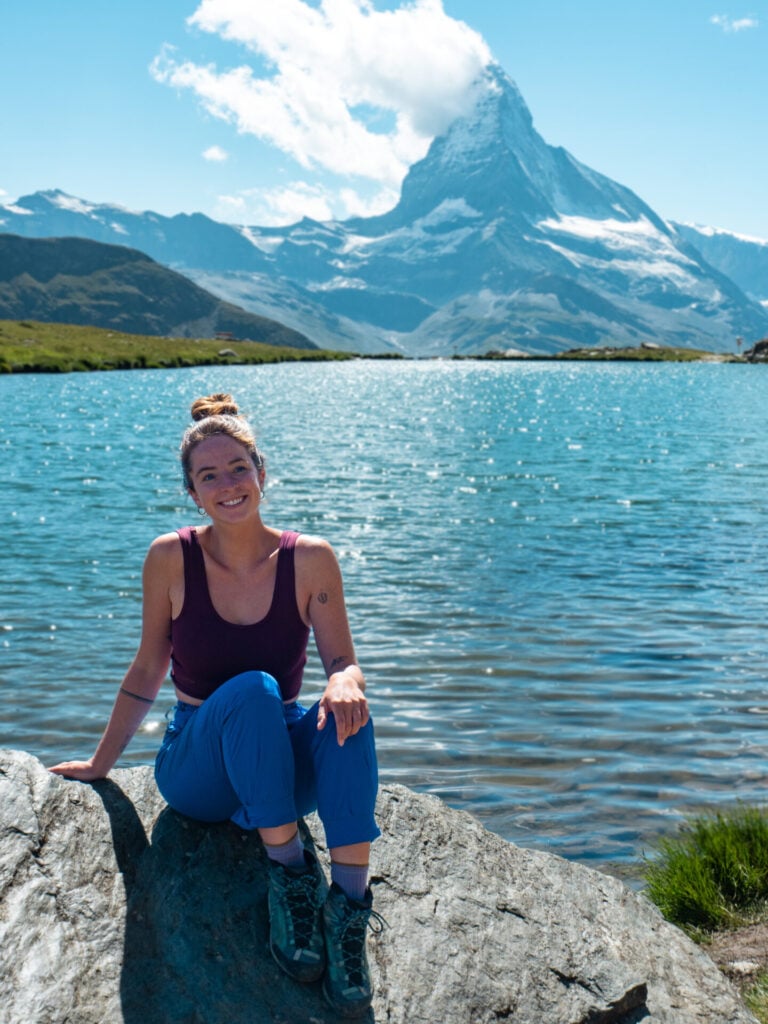
AM Day 3: Matterhorn Glacier Paradise (Klein Matterhorn)
At 3,883m, this is the highest cable car station in Europe, offering up-close views of the Breithorn and surrounding peaks from a truly dramatic icy perch. On a clear day, you can see Mont Blanc and the Italian Alps from the panoramic platforms without any hiking or climbing (though more intense activities are also possible!).
- Getting there: take the Matterhorn Express gondola from Zermatt Bergbahnen station to Trockener Steg (~30min), then transfer to the Matterhorn Glacier Ride cable car up to Glacier Paradise (~8min)
- Tickets: a return journey to Glacier Paradise costs 114CHF (57CHF with the Swiss Half Fare Travelcard); you can buy tickets at the base station or online
- Activities at Matterhorn Glacier Paradise:
- Walk the panoramic viewing platforms (1–2hrs)
- Hike the Matterhorn Glacier Trail (2–3hrs, descending 7km from Trockener Steg)
- Climb the Breithorn (4,164m), a beginner-friendly alpine summit with just 400m elevation gain, about 3-3.5hrs return from the station (note: even though this is an “easy summit”, crampons, rope, and glacier experience are ESSENTIAL, otherwise hire a guide!)
- On your way back down, stop at Trockener Steg for one of my favourite Matterhorn views without the crowds!
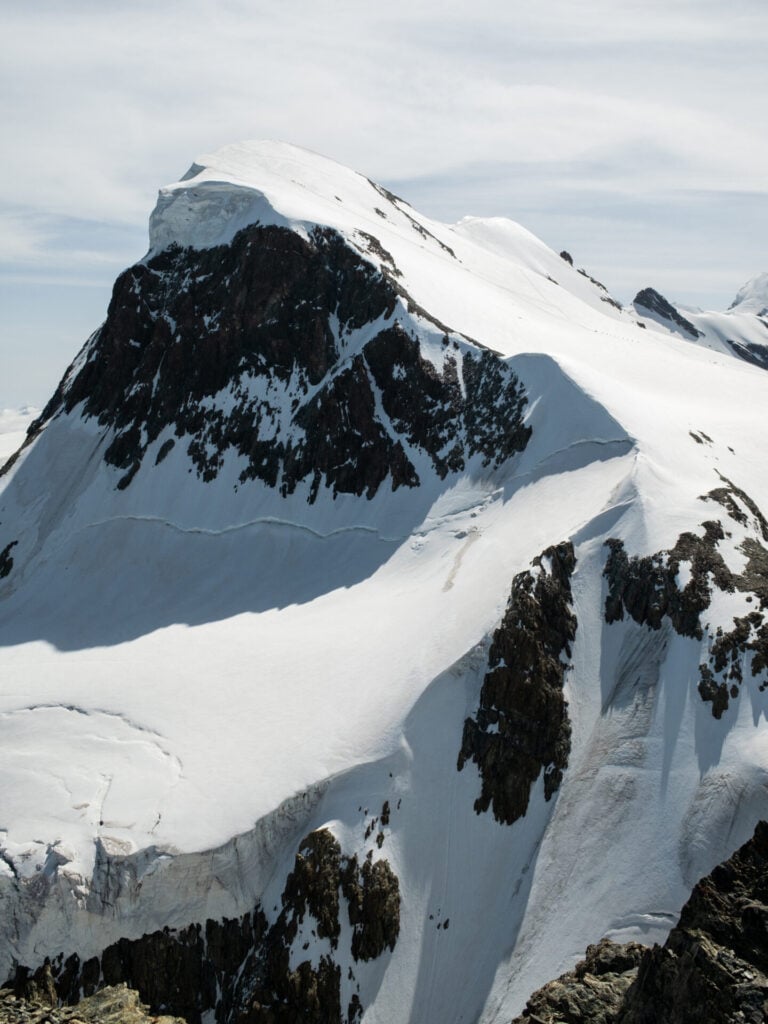
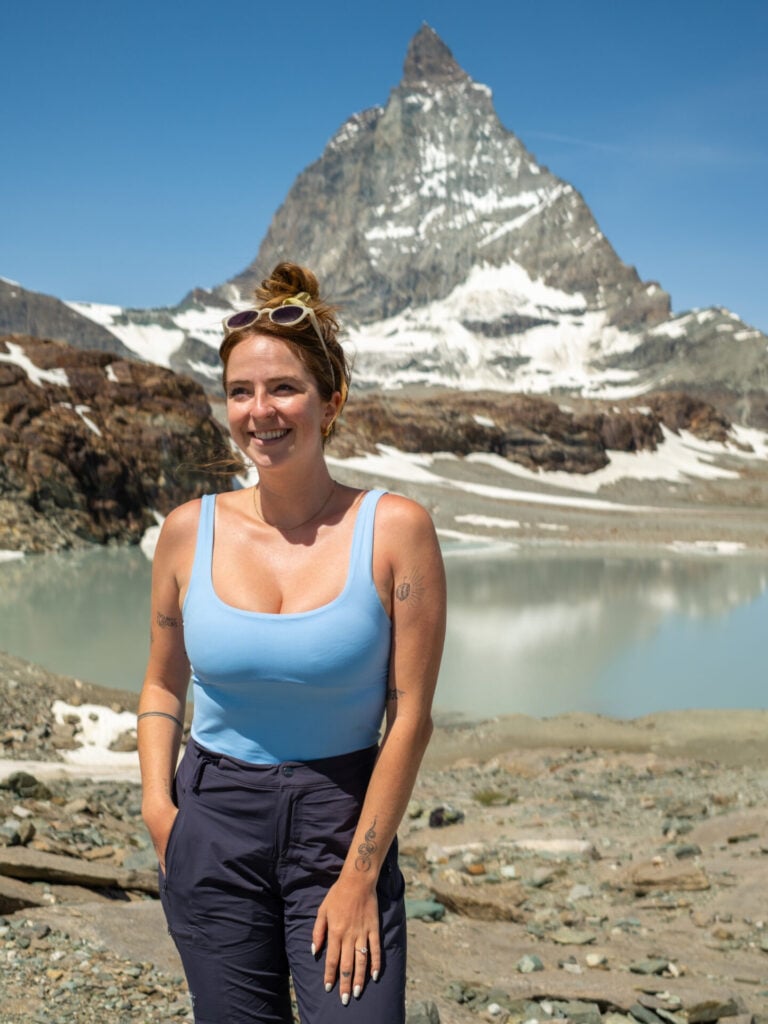
PM Day 3: explore Zermatt town
Wander through Zermatt’s charming, car-free village centre, where wooden chalets, boutique shops, and cozy cafés line the cobbled streets. Don’t miss a walk along the riverfront trail for stunning Matterhorn views, especially at sunrise or sunset!


If you want to mix things up a bit, you can also explore Matterhorn Glacier Paradise in the afternoon and keep the morning free for paragliding! I’ve done this previously on the other side of the Alps (Chamonix), but several friends went paragliding from Zermatt while we were all in town together and LOVED it. You can search for paragliding trips here.
🍕 I’m not recommending a long list of restaurants in this itinerary because, as previously mentioned, the food in Switzerland is extortionate… but if you do want a good-value meal out, our favourite spot in Zermatt is the North Wall Bar, which offers customisable oven-fire pizza and local craft beer at the best prices in town!


Where to stay in Zermatt
Once you arrive in Zermatt, keep in mind that the train station is located at the bottom of town, along with all of the supermarkets. The more affordable (and more scenic!) accommodations are all located about 1km uphill, which means a steep walk and a lot of stairs if you’re carrying luggage. I’ve stayed in town and up the hill across multiple trips and still prefer staying higher for the views, but it’s definitely something to consider when booking.
Note also that Zermatt is entirely car-free, but Hotel Jägerhof offers free train station pick-up and there are also electric taxis available to reach other hotels (like Hotel Berghof) if you don’t want to walk; expect to pay ~40CHF for a short trip uphill. As mentioned previously, if you’re travelling with 3+ people, Airbnb is typically the most affordable option, but booking early is essential!

Days 4-5: Interlaken
Tucked between Lake Thun and Lake Brienz, and flanked by soaring alpine peaks, Interlaken is one of Switzerland’s most iconic adventure hubs and a fantastic base for exploring some truly spectacular landscapes— including glacial lakes, scenic boat rides, and hidden alpine gems like Oeschinensee.
Getting to Interlaken
Take the train from Zermatt to Interlaken Ost, which takes just under 2.5hrs with two easy transfers— first in Visp, then again in Spiez. The entire journey is scenic and comfortable, with trains departing regularly throughout the day. Book tickets in advance for a better deal using the SBB app.
What to do in Interlaken
After arriving from Zermatt around midday on Day 4, you’ll have 1.5 days to explore the Interlaken area. You could easily spend more time here, but these are the absolute highlights I’d recommend:
PM Day 4: Lake Brienz cruise
Cruising on the turquoise waters of Lake Brienz was one of our favourite chilled-out activities in Switzerland and a great way to sightsee while giving your body a bit of a rest. The boat travels from Interlaken Ost to Brienz and back, and the entire round-trip offers spectacular views from start to finish.
- Getting there: upon arrival in Interlaken Ost, follow signs out of the train station (about 3min) to the pier, where scenic boats depart along Lake Brienz; since we were coming right off the train from Zermatt, we took our luggage on the boat and had no issue!
- Tickets: return fare costs 66CHF (33CHF with the Swiss Half Fare Travelcard) and can be purchased on-board the boat; we also highly recommend spending an additional 16CHF to upgrade to the “first class” ticket, which offers the best covered outdoor seating with guaranteed lake views!
- Time needed: the return trip from Interlaken to Brienz and back takes 2.5hrs, making it the perfect afternoon activity straight off the train from Zermatt


Sunset Day 4: Harder Kulm
If you’re still feeling energised after the Lake Brienz cruise, cap off the day with a ride up to Harder Kulm, Interlaken’s most accessible viewpoint. The glass viewing platform looks out over Lake Thun, Lake Brienz, Interlaken, and even the snowy trio of Eiger, Mönch, and Jungfrau on a clear day— sunset and golden hour are especially magical!
- Getting there: walk 5min from Interlaken Ost station to the Harderbahn funicular, which zips you up the mountain in just 10min
- Tickets: a return trip costs 38CHF (19CHF with the Swiss Half Fare Travelcard), no reservations required
- Time needed: allow ~1.5hrs, including the ride up, time at the viewpoint (and maybe a drink at the restaurant), and the ride back down; the funicular runs until around 9pm in summer
Day 5: Oeschinensee
For your second day in Interlaken, venture a short distance to one of the most magical alpine lakes in Switzerland— Oeschinensee, a bright blue glacial lake framed by sheer cliffs and waterfalls. Whether you want to hike, swim, paddle, or just chill on the lake’s pebbled beach, this is an incredible full-day adventure (and it’s so beautiful that we took our engagement photos here!)
- Getting there: take a train from Interlaken Ost to Spiez (24min) and change here for the train to Kandersteg (28min), then walk about 15min to the Kandersteg Gondola base station; the total journey takes about 1.5hrs, including transfer time
- Tickets: book train tickets through the SBB app and then use the self-service kiosks at Kandersteg to purchase return gondola tickets for 32CHF (16CHF with the Swiss Half Fare Travelcard)
- Activities at Oeschinensee: from the top of the gondola, it’s an easy 1.5km (20min) walk to the lake shore, where endless adventures await!
- Swim in the crystal-clear glacial water— all the families congregate on the main beach, but walk around the left shoreline to find quiet swim spots you can enjoy entirely to yourself
- Hike the Panorama Trail (Panoramaweg), an 8.5km loop with ~400m gain offering epic elevated views of the lake and surrounding cliffs (3–4hrs)
- Hike the Heuberg Viewpoint Trail, a 5km out-and-back to the best viewpoint above the lake (~250m gain, 1.5–2hrs)
- Stroll the Lake Circuit Trail (Seeweg), a relaxing 4km loop around the lake’s edge, perfect for photography or a picnic (flat, 1–1.5hrs)
- Time needed: including the 1.5hr journey from Interlaken to Kandersteg (each way), plus the gondola and hike to the lake, time for hiking, swimming, and photos, this is a full day activity— allow 8hrs round-trip from Interlaken!
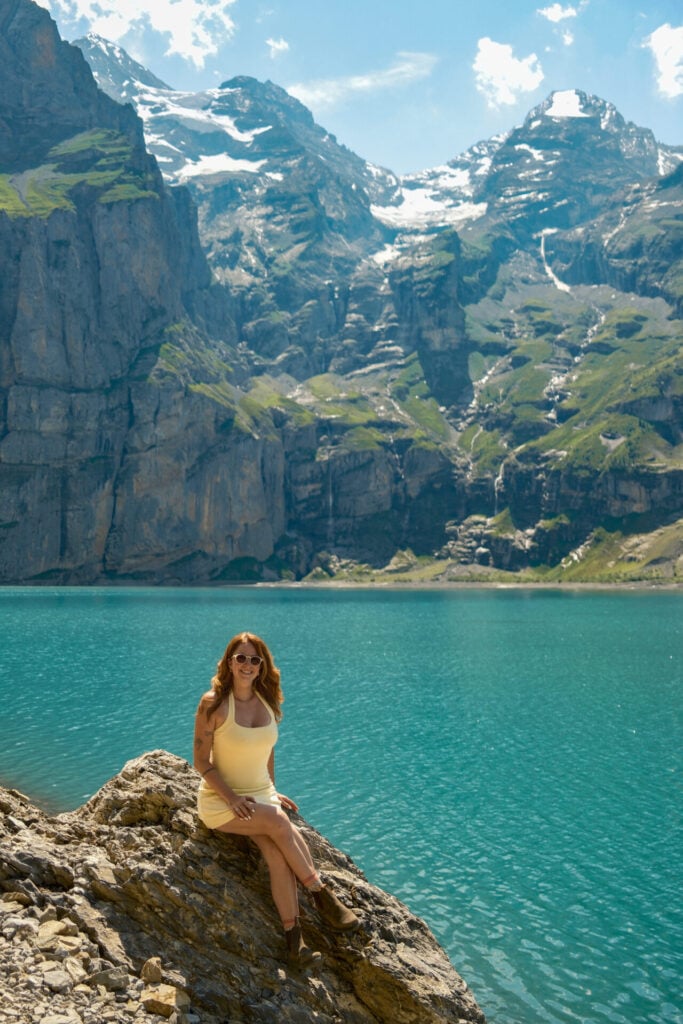
Where to stay in Interlaken
Spend 2 nights at Hotel Beausite, a charming, family-run hotel with alpine views, a generous breakfast spread, and a friendly, welcoming vibe. If you’re after a more affordable option, Hotel Alphorn is a clean and simple guesthouse just a short walk from Interlaken West station. Both are conveniently located for accessing the train station, local restaurants, and nearby activities on Lake Brienz and Harder Kulm.
ACCOMMODATION IN INTERLAKEN VS GRINDELWALD
This itinerary is written with 2 nights in Interlaken before Jungrafraujoch and 1 night in Grindelwald afterwards, but there are actually 3 reasonable options, depending on your preferences and availability/cost of hotels:
>> stay 2 nights in Interlaken + 1 night in Grindelwald (as it’s written here)— take an early train from Interlaken to Grindelwald Terminal on day 6, store luggage at the station before taking the lift to Jungfraujoch, then stay in Grindelwald that evening
>> stay all 3 nights in Interlaken— visit Jungfraujoch as a day-trip from Interlaken on day 6, catching the direct train to/from Grindelwald Terminal (30min) to access the Eiger Express lift
>> stay only 1 night in Interlaken, with nights in Grindelwald before & after Jungfraujoch— after Oeschinenesee on Day 5, catch the train to Grindelwald
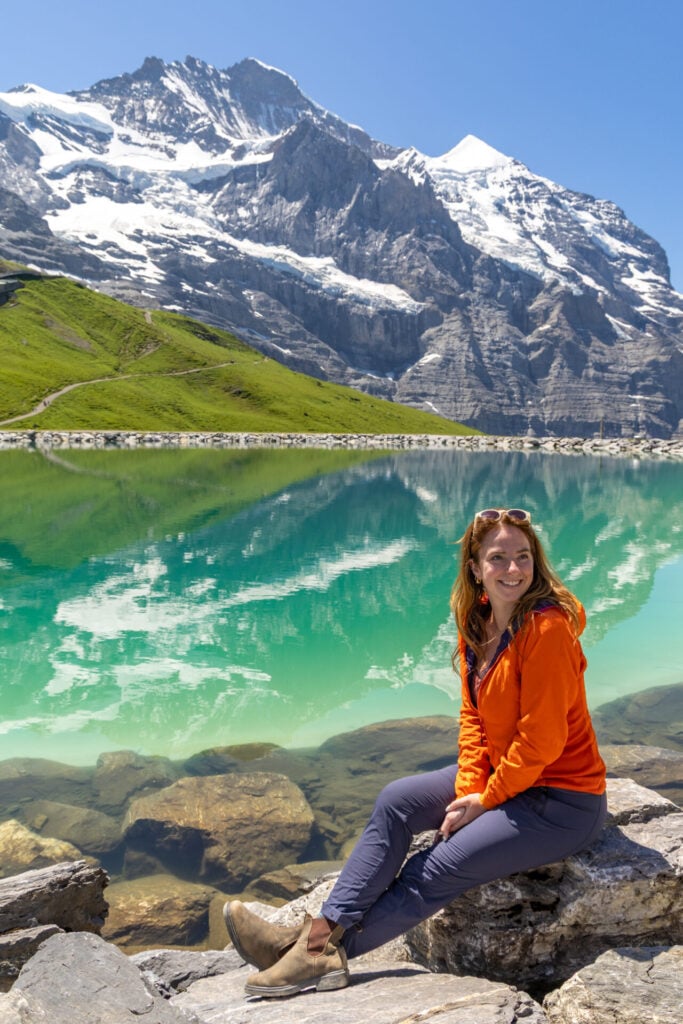
Day 6: Grindelwald & Jungfraujoch
The next essential stop in the Bernese Oberland takes you to the “Top of Europe”, the highest railway station on the continent, perched at 3,454m on the saddle between the iconic Jungfrau and Mönch peaks. Yes, it’s touristy and wildly expensive— but with a full day to explore Jungfraujoch, Kleine Scheidegg, and some seriously beautiful alpine trails, we felt it was absolutely worth it.
Getting to Grindelwald Terminal
Catch a direct train from Interlaken Ost to Grindelwald Terminal, which takes 30min and runs frequently throughout the day. If you’re following this itinerary as written, you’ll be leaving early on the morning of Day 6, so plan to store your luggage in lockers at Grindelwald Terminal while you’re exploring the mountains.
(If you don’t want to deal with luggage storage, see alternate accommodation options under Where to stay in Interlaken above).
Getting to Jungfraujoch
From Grindelwald Terminal, the journey to Jungfraujoch involves two legs:
- Eiger Express gondola from Grindelwald Terminal to Eigergletscher (15min)
- Train from Eigergletscher to Jungfraujoch (25min), travelling through a tunnel inside the Eiger
🎟️ Tickets: the return trip to Jungfraujoch costs a whopping 238CHF (124CHF with the Swiss Half Fare Travelcard) and is one of the most popular excursions in Switzerland, so it’s best to book a few days in advance; choose one of the earliest time slots (~8am) to avoid crowds AND maximise your chances of clear skies!
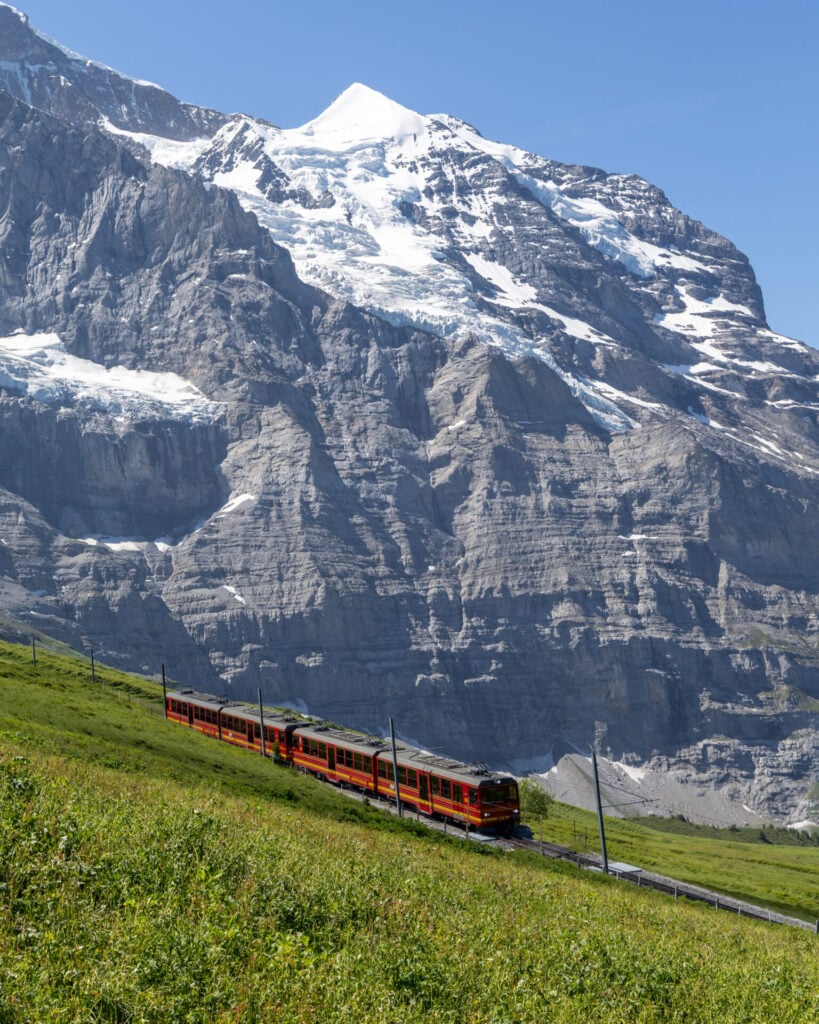
What to do at Jungfraujoch
Once at the top, allow 1.5–2hrs to follow the signed route through all the main attractions:
- The Sphinx Observatory for panoramic glacier views
- The Ice Palace with intricate ice sculptures and frozen tunnels
- The Glacier Plateau, where you can walk out onto the snow for views of the Aletsch Glacier
- Alpine Sensation, a light-filled underground tunnel walk that connects the buildings
- Several viewpoints and photo spots overlooking the surrounding 4,000m peaks
🧊 Bring warm layers (a down jacket & gloves)— even in summer, temperatures at the top can be below freezing!
→ Eiger Walk (1km, 270m gain, 1hr)
After exploring the summit, catch the train from Jungfraujoch to Kleine Scheidegg (35min) and begin the Eiger Walk, a short but beautiful trail that leads back up to Eigergletscher. Allow up to 2hrs if you’re a photographer! Highlights includes close-up views of the Eiger North Face, the gorgeous sparkling lake above Kleine Scheidegg, and the classic red Wengernalpbahn train curving through alpine meadows.
→ Eiger Trail (6km, 800m loss, 2hrs)
If you’re still feeling strong and want to extend the day, the Eiger Trail is another spectacular (and reasonably easy) alpine hike, running directly beneath the vertical wall of the Eiger’s North Face. From Eigergletscher, descend on a steep, rocky, but well-marked train to Alpiglen, where you can catch the train back to Grindelwald.
All of these activities will easily fill your day, so plan to dedicate all of Day 6 to Jungfraujoch and the Eiger trails!
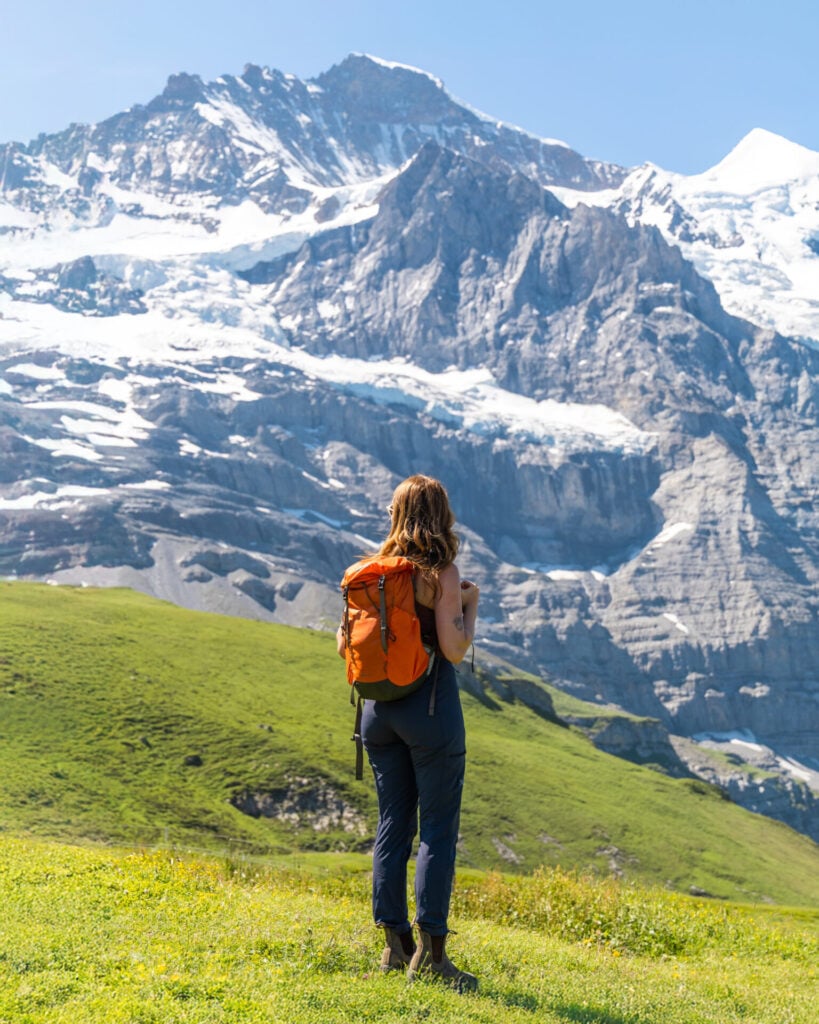
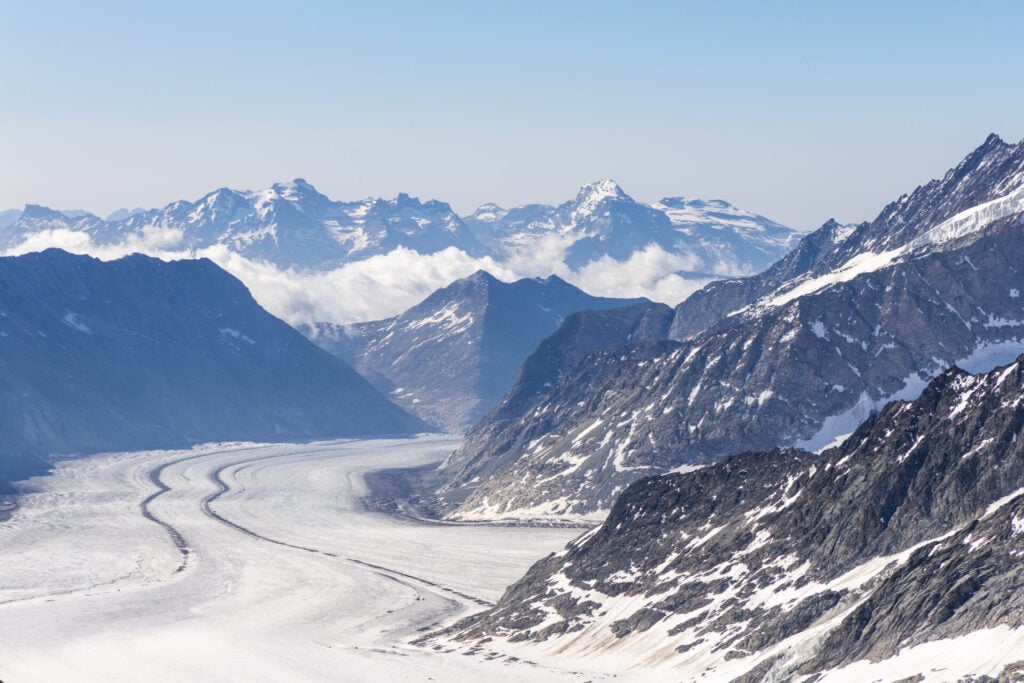
Where to stay in Grindelwald
If you want to be closer to restaurants and shops in Grindelwald, book 1 night at Derby Swiss Quality Hotel, located right next to the main train station in the centre of town. If you’d rather prioritise easier access to Jungfraujoch, Eiger Lodge Chic is a fantastic alternative, situated right beside the Eiger Express gondola and offering stylish, modern rooms at a great value (short train ride or 25min walk up to town).
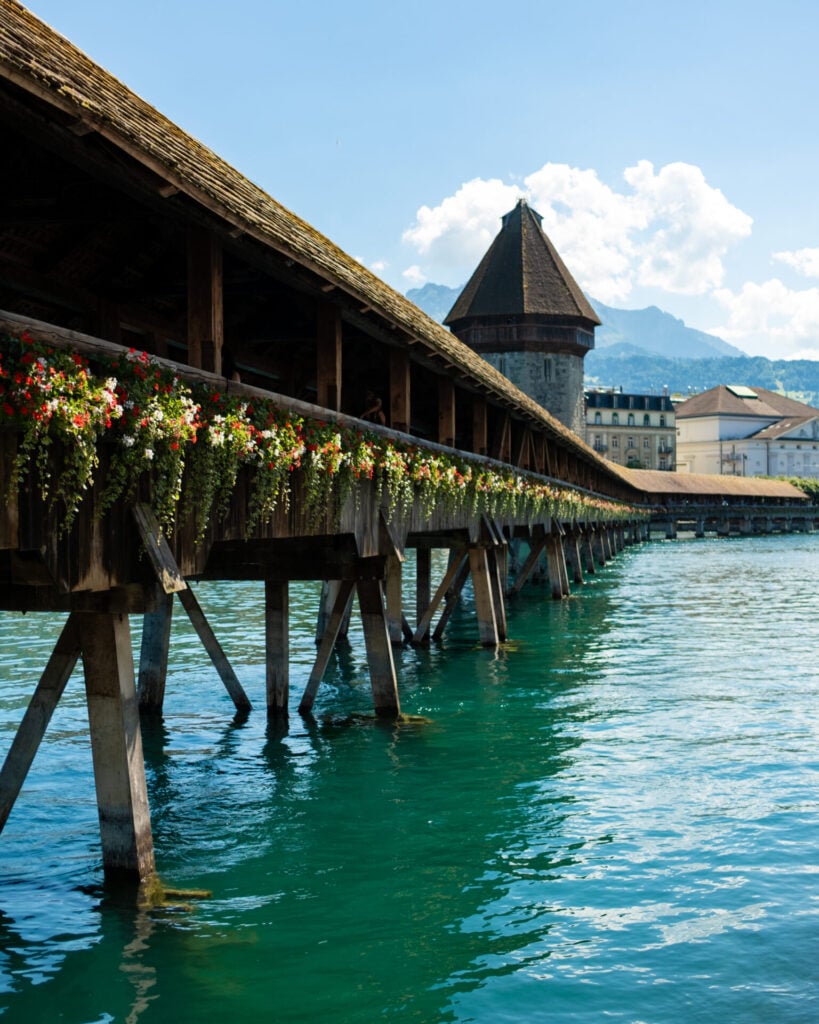
Days 7-8: Lucerne
With its sparkling lake, snow-capped peaks, and beautifully preserved medieval old town, Lucerne is easily one of Switzerland’s most picturesque cities. Over the next 2 days, explore cobbled streets and historic bridges, ride the world’s steepest funicular, and hike one of the most scenic ridgelines in the country!
Getting to Lucerne
The train from Grindelwald to Lucerne takes about 2.5hrs, including one transfer in Interlaken (if you opted to stay all 3 nights in Interlaken, the journey is direct and takes under 2hrs). Book tickets in advance for a better deal using the SBB app.
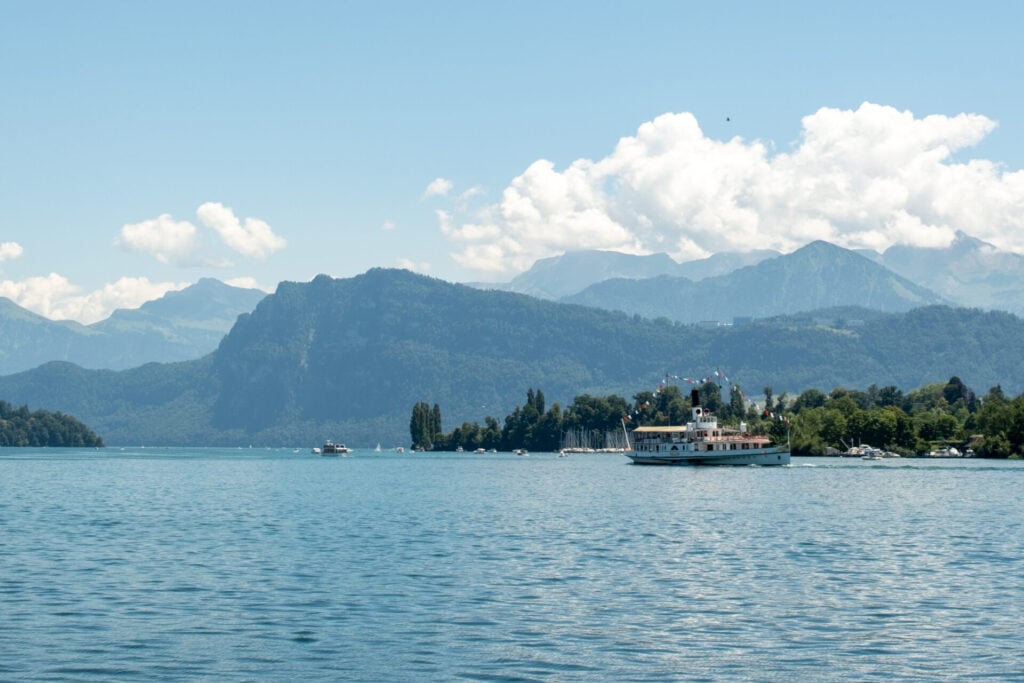
What to do in Lucerne
PM Day 7: explore Lucerne town
After arriving in Lucerne from Grindelwald, use your first day to explore the charming town centre and lakeside:
- Chapel Bridge (Kapellbrücke): Lucerne’s most famous landmark, this 14th-century covered wooden bridge is decorated with colourful paintings and flanked by a medieval water tower
- Old Town (Altstadt): wander through cobbled streets lined with frescoed buildings, artisan shops, and cafes with lake views.
- Lion Monument (Löwendenkmal): a beautiful rock carving commemorating Swiss Guards who died during the French Revolution
- Lake Lucerne cruise: 1-2hr scenic boat rides leave regularly from the terminal near the train station
- Mt Pilatus summit: take the cable car from Kriens or the cogwheel train from Alpnachstad to the summit of Mt Pilatus (2,128m) for panoramic views over Lucerne and the surrounding Alps



Day 8: Stoos Ridge
Just an hour from Lucerne, Stoos Ridge is one of the most scenic and rewarding short hikes in central Switzerland. This knife-edge trail follows a dramatic ridgeline above Lake Lucerne, with panoramic views of alpine peaks, turquoise lakes, and rolling green valleys the entire way.
- Getting there: the train from Lucerne to the Schwyz Stoosbahn takes a little over an hour, including a single transfer in Schwyz (or Arth-Goldau); from here, ride the Stoos funicular (the steepest in the world!) up to the car-free mountain village of Stoos and the Fronalpstock chairlift to the ridge-top
- Tickets: tickets for the Stoos funicular + chairlift combo cost 57CHF return (40CHF with the Swiss Half Fare Travelcard), available at the base station without reservation
- Hike details: follow the 4.5km trail along the ridgeline to Klingenstock, with undulating terrain and constant panoramic views over Lake Lucerne, the Mythen peaks, and countless alpine summits; if you’re short on time or energy, you can also ride the chairlift up to Fronalpstock, enjoy the summit viewpoint, and hike just a short section of the ridge before returning the same way
- Time needed: allow 6–7hrs total for the return trip from Lucerne, including transport, lift rides, and time on the ridge; on Saturday evenings (May–mid‑Sept), the Fronalpstock chairlifts also stay open until 10 pm so you can enjoy one of the most magical sunsets in the Alps without having to hike all the way down!
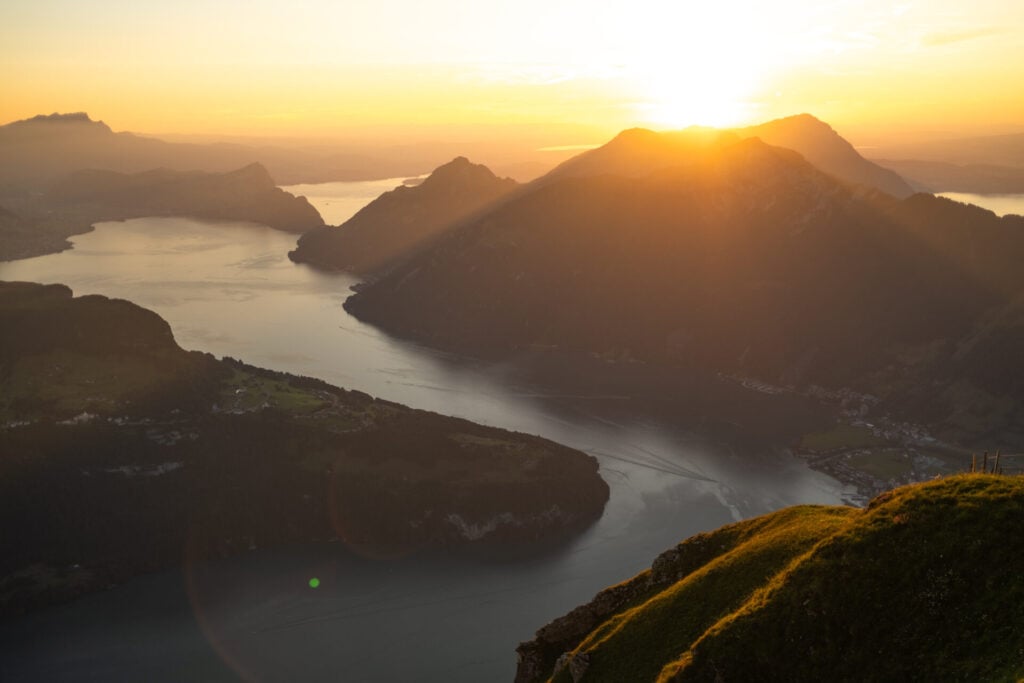
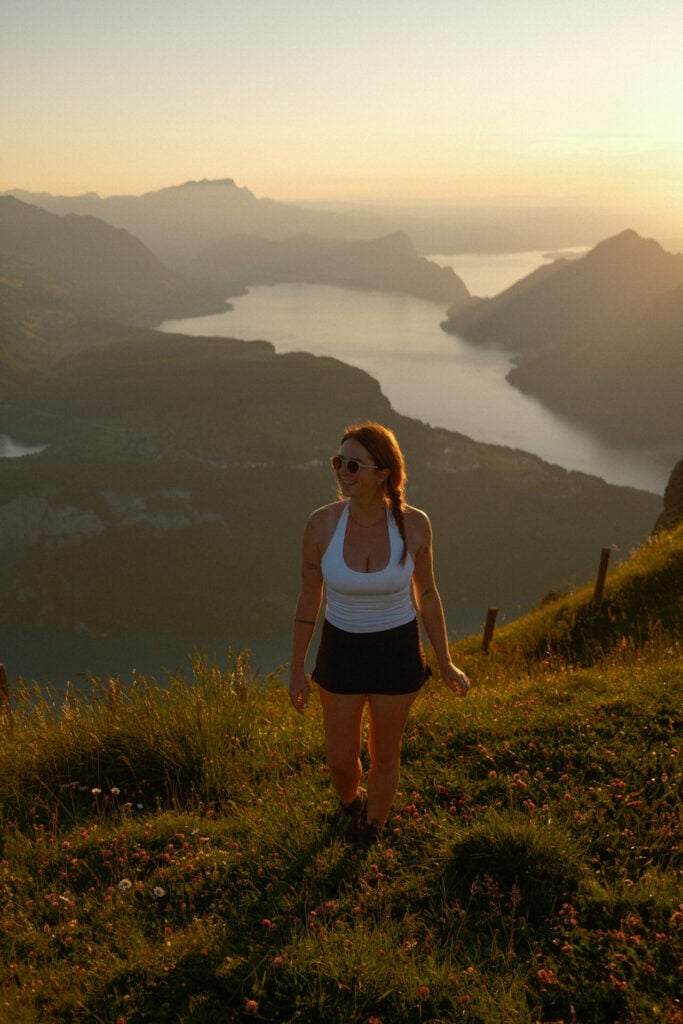
Where to stay in Lucerne
Stay 2 nights at GLANDON Rooms Haldenhof, offering simple, spacious studios with kitchenettes (perfect if you want to self-cater!) and direct access to the lake for a sunset swim. Alternatively, Hotel Royal Luzern is a classic option with old-school charm, panoramic lake views, and a peaceful location just a 15min walk from the Old Town.
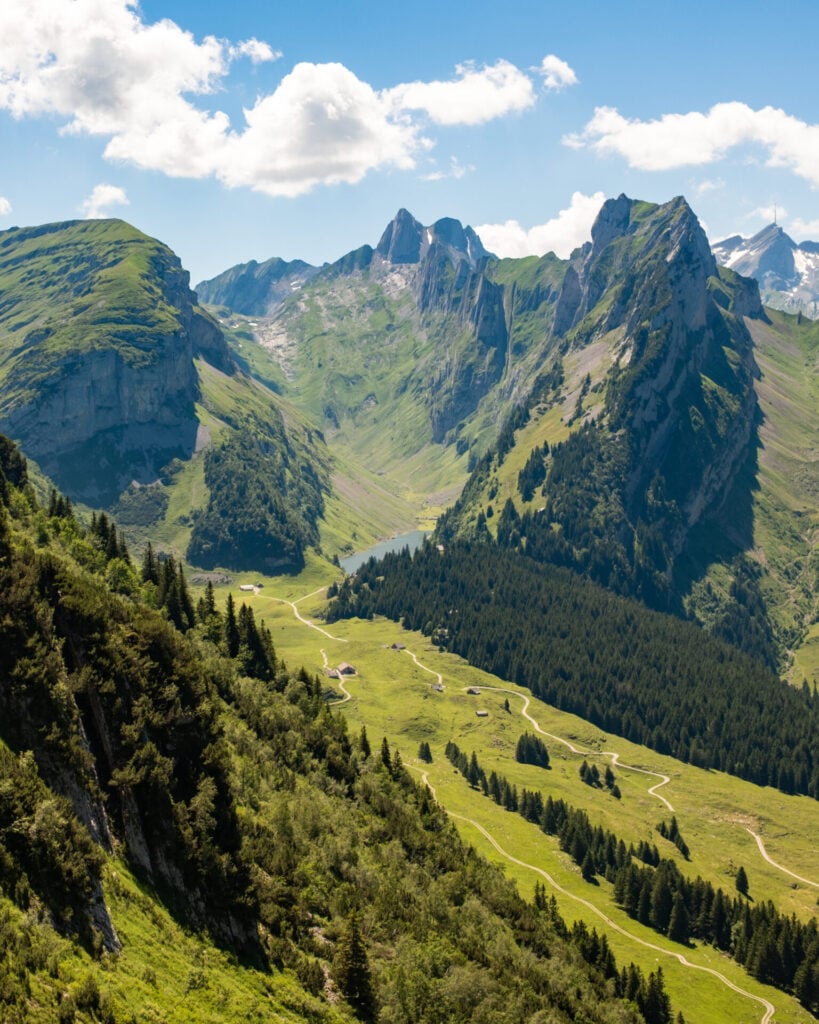
Days 9-10: Appenzell
Tucked in the rolling green hills of northeast Switzerland, the Alpstein Mountains are one of the country’s most underrated (but incredible!) alpine regions. You could easily spend a week or more exploring the dramatic ridgelines, flower-filled meadows, and alpine lakes, but with just 2 days, you can still tackle the most iconic trails: Schäfler Ridge and Saxer Lücke.
Getting to Appenzell
On Day 9, take the train from Lucerne to Appenzell, which takes just under 3hrs with one easy transfer in either Gossau or Herisau. Trains run frequently throughout the day, and you can book your ticket in advance via the SBB appfor the best price.
What to do in Appenzell
PM Day 9: Schäfler Ridge
Arriving from Lucerne on the train around midday, you’ll have time to tuck in an epic golden hour hike to Schäfler Ridge, indisputably one of the most jaw-dropping vistas in all of Switzerland!
- Getting there: in less than 15min, connect from Appenzell to Wasserauen by train and then onto the Ebenalp Cable Car
- Tickets: return cable car tickets cost CHF 34 (or CHF 17 with the Swiss Half Fare Travelcard), available at the base station in Wasserauen
- Hike details: from the top of the lift at Ebenalp, it’s a fairly easy 2.5hr return hike (6km, 380m gain) to the Schäflerhutte and a series of epic ridge top viewpoints just beyond
- Time needed: allow ~4hrs total from Appenzell, including train and lift transit, the hike itself, and time to photograph the viewpoints before returning to your hotel
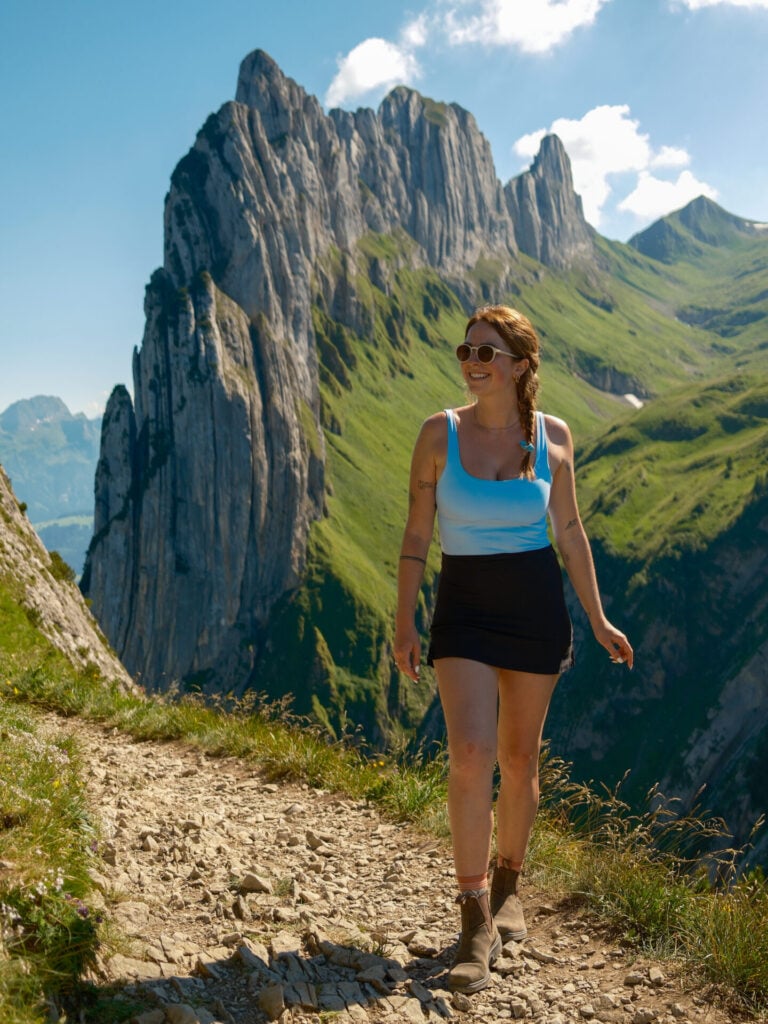
Day 10: Saxer Lücke
With its razor-sharp ridgeline, vertical limestone walls, and sweeping views over Lake Fählensee, Saxer Lücke is yet another of the most jaw-dropping landscapes in the Alps. It’s especially magical in the late afternoon, when the sun lights up the cliffs and the valley below glows in golden light— a dream for photographers and hikers alike!
- Getting there: in just 15min, catch the train to Weissbad and a bus onwards to the Hoher Kasten Valley Station in Brülisau; with a car, you’ll also have the option of a shorter hike from Frümsen (only a 40min drive, but highly impractical via public transport)
- Tickets: return tickets for the Hoher Kasten cable car cost CHF 48 (or CHF 24 with the Swiss Half Fare Travelcard); for a shorter hike, the Frümsen–Staubernkanzel self-service cable car costs CHF 40 return (no Half Fare discount), paid on-site at the kiosk
- Hike details: from the cablecar, follow an undulating trail to Staubernkanzel (an alpine hut serving food and drink) and then down to Saxer Lücke, continuing onwards to Lake Fählensee and eventually back Brülisau for a ~6hrs loop (19km, 500m gain, 1400m loss); alternatively, you can take the cable car from Frümsen directly to Staubernkanzel and then hike 1hr each way to Saxer Lücke (5km total, 300m gain)
- Time needed: with transit time from Appenzell and one million photos, this is a full-day activity (although either of the hikes are only 6hrs or 2.5hrs on actual trail time)
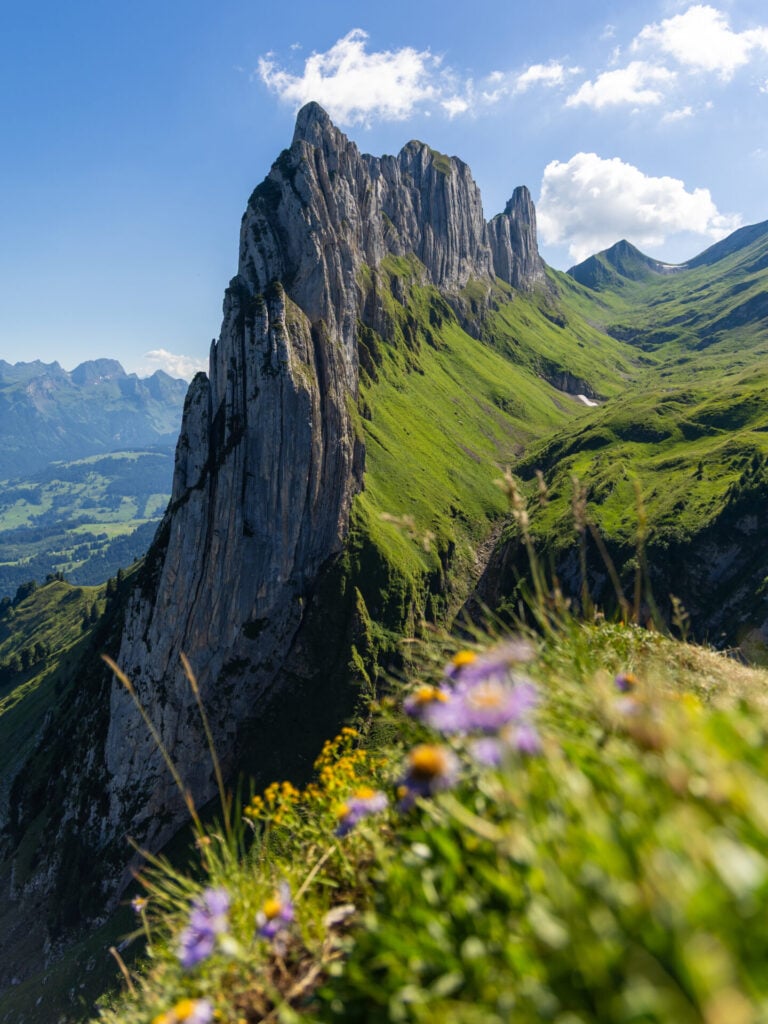
Where to stay in Appenzell
Spend 2 nights at either Hotel Löwen or Hotel Adler, both mid-range guesthouses located in the heart of Appenzell village. You’ll be within walking distance of cafés, bakeries, and the train station, making it easy to access trailheads for Schäfler Ridge and Saxer Lücke without a car.
Day 10: to the Zürich airport
On the final morning of your trip, catch the train from Appenzell to Zürich Airport (Flughafen)—a straightforward 1.5hr journey with just a single transfer in Gossau. Sit back, enjoy one last look at the rolling green hills, and say farewell to Switzerland (for now)!
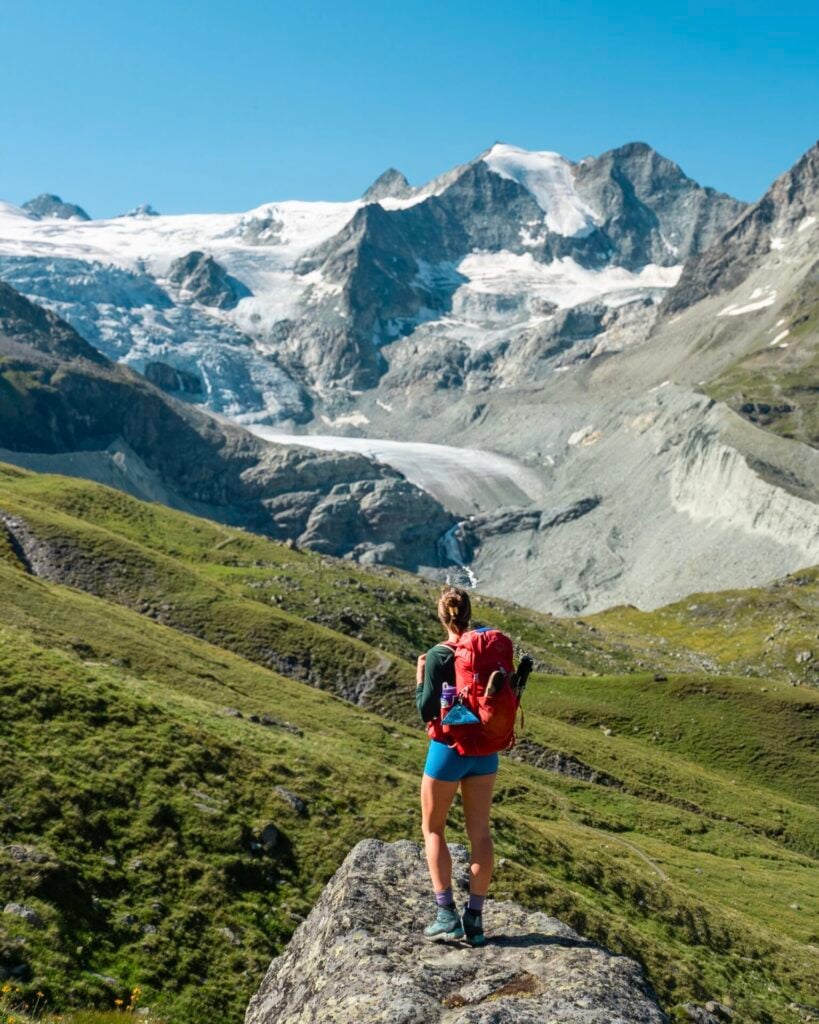
Switzerland itinerary extensions
- With 2 weeks? We’d most recommend adding extra time in the Alpstein Mountains around Appenzell— this region is packed with world-class hikes like the Lisengrat ridge, Seealpsee, and the full Schäfler loop. You could also add a few days in the Lauterbrunnen Valley, staying in Mürren or Wengen and soaking up the views with easy access to waterfalls, cable cars, and the famous Schilthorn summit.
- With a longer trek incorporated? The Walker’s Haute Route from Chamonix to Zermatt (10-12 days) or the Tour du Mont Blanc (passing through the Swiss Alps around Champex; 8-11 days) are both truly EPIC and so worth an add if you’re looking for a true active itinerary
Other adventure itineraries
2-week Patagonia itinerary: best of Torres del Paine & Los Glaciares/El Chaltén
2-week Montenegro road-trip itinerary: epic hiking, Riviera beaches & wine country
2-week Mexico volcanoes itinerary: climbing Pico de Orizaba, Izta, Malinche & Toluca
10-day Rwanda road trip itinerary: gorillas, volcanoes & Lake Kivu
